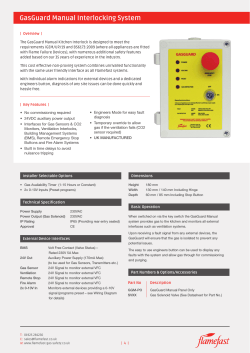
How to improve the EPBD impact, how to assess better innovations?
© Aereco 2008 Jean-Luc Savin, Aereco (EuroACE member) ASIEPI Web event, 25 February 2009 How to improve the EPBD impact, how to assess better innovations? The point of view of EuroACE and Aereco © Aereco 2008 Founded in 1998 by 20 of Europe’s leading companies involved with the manufacture, distribution and installation of energy saving goods and services. In response to European Council of Ministers proposals to combat the threat of climate change, which completely ignored any potential for reducing energy consumption in buildings. EuroACE works together with the European institutions to help Europe achieve greater sustainable energy use in buildings and significant reductions in carbon dioxide emissions. © Aereco 2008 22 members in 2009 Acciona Aereco Armacell International BING CRH Danfoss Honeywell Hunter Douglas Huntsman Polyurethanes Tremco illbruck Kingspan Insulated Panels Knauf Insulation Paroc Philips Lighting Pilkington Rockwool International Saint-Gobain Isover Skanska Somfy United Technologies URSA Insulation VELUX A/S © Aereco 2008 A cross-sector representation Ventilation Roof insulation Glazing Floor Insulation Heating/cooling controls On-site alternative energy installations Lighting Wall insulation Boiler/cooler Regenerative Drive Elevators © Aereco 2008 Goals The challenge: To ensure that not only is the potential for saving energy in buildings recognised, but policies are introduced. To stimulate investment in all energy efficiency measures in buildings. Methods: Continuous dialogue with those in the European Union charged with delivering programmes. Several substantial research projects, intended to facilitate effective policy making in this area and expand the market for EuroACE's members' products and services. © Aereco 2008 Contact EuroACE Avenue Louise 375 - Bte 4 BE-1050 BRUSSELS Tel.: +32 (0) 2 639 10 10 Fax: +32 (0) 2 639 10 15 www.euroace.org info@euroace.org © Aereco 2008 Research, design and manufacture of energy efficient domestic ventilation systems Founded in 1984 Head office and factory in France, 10 subsidiaries and offices Worldwid 250 employees Inventor of the humidity sensitive ventilation system in 1984 Specialised in Demand Controlled Ventilation © Aereco 2008 Assessment of Demand Controlled Ventilation (DCV) in the EPB 3 cases in the EU: Assessment and value available in the regulation framework (France, Humidity controlled ventilation) Assessment not available in the “standard” tools, but specific procedure/method to assess the performance (ATG- E in Belgium) No possibility to assess or value the performance of DCV (case of most of the countries) © Aereco 2008 Assessment of Demand Controlled Ventilation in France Technical Approval (delivered by CSTB*) To assess energy savings and indoor air quality when using Demand Controlled Ventilation Predictive energy consumption and indoor air quality by the mean of an ad hoc dynamic software (SIREN) * Centre Scientifique et Technique du Bâtiment © Aereco 2008 Occupation scenario Dwelling configuration DCV system SIREN software Indoor Air Quality (cumulated ppmh CO2) “Equivalent” constant airflow Weather conditions © Aereco 2008 Constant airflow Ventilation system Demand Controlled Ventilation system Regulation (« arrêté du 24 mars 1982 ») Technical approval Requirement of a constant airflow depending on the dwelling type “Equivalent” constant airflow Calculation tool Energy performance of the dwelling © Aereco 2008 Assessment of Demand Controlled Ventilation in France Principle of equivalence (average controlled airflow equivalent to a constant airflow at same IAQ), given by technical approval delivered by CSTB. Advantage = enable the use of the existing calculation tools. BUT need of complementary certified supports (technical approvals). © Aereco 2008 To assess a product… or a system? EPBD’s principle is to improve the global performance of the building. The energy performance of a product depends strongly on its: Environment (system and other influencing elements) Tests conditions © Aereco 2008 To assess a product… or a system? High performance system Engine X CAR EU energy label © Aereco 2008 To assess a product… or a system? Engine X Low performance system CAR EU energy label © Aereco 2008 To assess a product… or a system? Same engine, different car energy performance… The complete system can be energy-labeled, not the product/component. © Aereco 2008 To assess a product… or a system? Application on HVAC systems: Constant airflow extract units Fan (optimised for DCV) 88 kW.h per year EU label for ventilation: « ECODESIGN Lot 10 Environmental performance of residential room conditioning appliances (airco and ventilation) » Constant airflow extract units © Aereco 2008 To assess a product… or a system? Application on HVAC systems: Demand controlled extract units Fan (optimised for DCV) Demand controlled extract units 52 kW.h 88 per year A fan EU label does not enable to assess the effective performance of the product and the system. © Aereco 2008 To assess a product… or a system? Application on HVAC systems: Demand controlled extract units Fan (optimised for DCV) Demand controlled extract units 52 kW.h 88 per year The use and the environment of the product should always be taken into account to assess its EU energylabel. © Aereco 2008 Regulations and innovation Regulations = Picture of the state-of-the-art with the available technologies. Regulations can be considered as barriers for innovation as soon as they are not able to value improvements on energy performance supplied by a new technology. Need for frequent evolutions of regulations and calculation tools to better take into account efficient innovations. © Aereco 2008 Conclusions The lack of assessement procedures and the length for technical approvals are real barriers for innovations in regard with EPBD. Assessment of complete system is more representative than a product or component assessment. Principle of “equivalence” is a fast and efficient way to enable and to assess innovation without revolutionning the existing tools. While calculation tools must be easy to use, simplification is not always possible: it does not enable to take into account the specifities of the innovations. © Aereco 2008 Thank you for your attention
© Copyright 2025





















